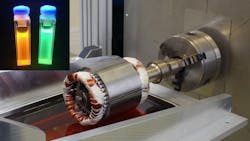Electric Vehicles, Unplugged
There will be more to the coming electric vehicle revolution than simply figuring out where and how often to refuel. There will be several internal engineering challenges when it comes to maintenance and repair that will change the way we relate with our cars and trucks.
As a recent Machine Design article notes, scientists at Martin Luther University Halle-Wittenberg (MLU), in collaboration with ELANTAS—a division of the specialty chemicals group ALTANA—attempted to address the issue of identifying wire wear in electric vehicles by developing an integrated dye process that allow them to detect wear on an electric motor’s cable insulation.
The researchers chose a dye that normally glows reddish orange under UV light, but changes to a light green when alcohol binds to it. The different color spectra, they explained, could then be analyzed using special devices that could be installed directly in the engine.
“This way, you can see if a replacement is necessary without having to open up the engine,” said Professor Wolfgang Binder from the Institute of Chemistry at MLU.
EV Lubricant Issues
Another issue is lubrication. There are fundamental differences in EVs and internal combustion engines, which requires a different approach to the engineering, and to the lubricants.
“The lubricants and fluids in EVs will have some new jobs to do,” said Jeff Hemphill, CTO of Schaeffler Group, an automotive supplier, in a Machine Design article that first appeared in Tribology & Lubrication Technology, the monthly magazine of the Society of Tribologists and Lubrication Engineers. “For example, automatic transmission fluid in today’s conventional vehicles must handle controlled friction in wet clutch packs, remove heat from the clutches and do both for more than 100,000 miles.
“In electric axle gearboxes, heat might need to be removed from the electric motor and there will likely be no clutch packs,” he added. “This might make the transmission fluid’s viscosity and specific heat more important than its ability to reduce or change friction.”
Ali Erdemir, professor of mechanical engineering and materials at Texas A&M University, agrees. “There are fewer moving components in EVs, so there are fewer types of lubricants needed,” Erdemir said. “These might differ from those used in internal-combustion engines, mainly because of the differences in contact load, speed and heat, which may call for better anti-wear, anti-scuff capabilities.”
“Electric vehicles have no combustion processes to deal with, so there is no engine oil in the conventional sense,” adds Edward P. Becker, P.E., president and founder of Friction & Wear Solutions, LLC. “This is the biggest change. However, EVs still use many of the same lubricants.
“For example, greases for wheel bearings, suspension components and body closures are essentially the same,” he explains. “To date, all EVs use conventional transmission fluids to lubricate the motor and gears. A new lubricant designed for high loads at low speeds will be required for future EVs.”
John Burke, CMFS, global director of engineering services, Quaker Houghton, concurs: “Electric cars can accelerate faster than conventional cars; therefore, they may put more stress on lubricants in powertrain components.”
About the Author

Bob Vavra
Editor Emeritus, Machine Design and Power & Motion
Bob Vavra is the former senior content director of Machine Design and Power & Motion.
